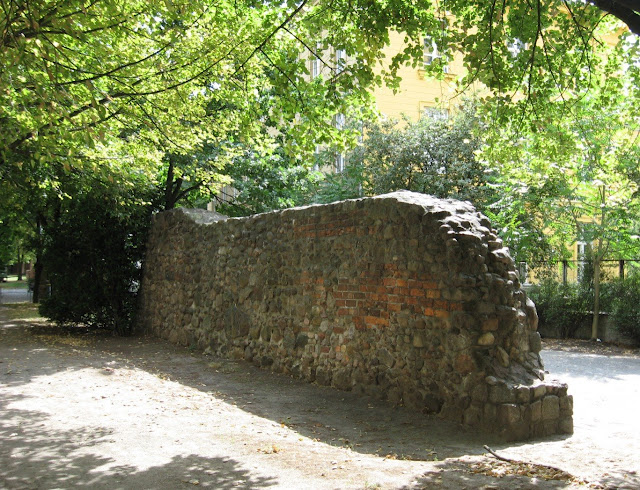Most people think of Berlin as a modern bustling town built out of the wreckage of the 19th and 20th century. But Berlin has a much longer and interesting – medieval – history
Around 1170 Berlin was founded on two opposing plateaus: Barnim and Teltow, located on either brink of the river Spree, a tributary to Havel, which feeds the Elbe. The first Berliners were German colonists from the Harz, the Rhineland, Westphalia and Flanders. When they arrived the land was marshy, forested and in fact not very inviting. However, ancient Slavic trading routes along the rivers from West to East passed through and made it an inviting spot to locate a market.

The beginnings were modest. Berlin and Cölln were located on the sandy islands, each with a few wooden houses and a small-timbered church. However, two generations later (around 1230) the Ascanian Margraves: Johann I and Otto III presented the market with city-status exempting them from taxes. The emblem of the House of Ascania, a red eagle and bear, became the heraldic emblems of Berlin.
This investment paid off. A few decades later the Ascanians derived huge profits from customs, tolls and fees on market stands and the use of the mills of the city. The city status started a construction boom in Berlin. First of all the Mühlendamm (Mill Damm) was built on a huge number of massive oak trunks. This linked the two sister cities and at the same time dammed the Spree. This allowed the city to exploit the river in two ways. First off all this forced riverboats to reload their freights, inviting the traders to market their wares at the local market. Secondly the water was used in milling and other forms of crafts and trades (processing cloth, tanning hides etc.) At this time a series of large stone churches were built. St. Nikolai was the first. Later (1270) the Franciscans built the first brick-church echoing the prevalent mode of church building in Northern Germany.
 The city itself was the result of a planned exercise. Spandauer Strasse, Jüdenstrasse and Klosterstrasse ran parallel to each other with plots of land in given to new settlers. Amongst these were the Jews, who were given a separate gated area at the Grosse Jüdenhoff with a synagougue off the Molktenmarkt. Jewish merchants, who were involved in money exchange and the credit business, were among the first settlers. On the other side at the city’s North-Eastern edge, the Margraves reserved a piece of land for themselves.
The city itself was the result of a planned exercise. Spandauer Strasse, Jüdenstrasse and Klosterstrasse ran parallel to each other with plots of land in given to new settlers. Amongst these were the Jews, who were given a separate gated area at the Grosse Jüdenhoff with a synagougue off the Molktenmarkt. Jewish merchants, who were involved in money exchange and the credit business, were among the first settlers. On the other side at the city’s North-Eastern edge, the Margraves reserved a piece of land for themselves.
In the mid-13th century Berlin expanded towards the north-west. The Mariensiedlung residential area grew up around the Neuer Markt, with houses with tiled roofs. At this time the twin city began building city walls in order to replace the older earthwork and palisade fortifications. Around this time more than 2000 people lived within the city’s walls and Berlin had become a major foreign trade hub. From East came wood, rye and linen, salt came from Halle, herrings from the Baltic and cloth from Flanders and the more local textile production centres in Brandenburg. At the end Berlin became a member of the Hanseatic League.
This story is told in much details in a new book, which was recently published in connection with the “Historiale 2012” focusing on the 775 anniversary of Berlin.
Information about medieval buildings and ruins in Berlin
Read more about “The Historiale 2012”
